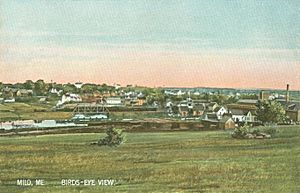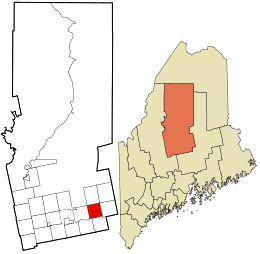Milo, Maine facts for kids
Quick facts for kids
Milo, Maine
|
|
|---|---|

Bird's-eye view c. 1910
|
|

Location in Piscataquis County and the state of Maine.
|
|
| Country | United States |
| State | Maine |
| County | Piscataquis |
| Incorporated | 1823 |
| Area | |
| • Total | 33.96 sq mi (87.96 km2) |
| • Land | 32.98 sq mi (85.42 km2) |
| • Water | 0.98 sq mi (2.54 km2) |
| Elevation | 322 ft (98 m) |
| Population
(2020)
|
|
| • Total | 2,251 |
| • Density | 26.4/sq mi (10.2/km2) |
| Time zone | UTC-5 (Eastern (EST)) |
| • Summer (DST) | UTC-4 (EDT) |
| ZIP code |
04463
|
| Area code(s) | 207 |
| FIPS code | 23-46020 |
| GNIS feature ID | 0582597 |
| Website | https://www.trcmaine.org/community/milo |
Milo is a town in Piscataquis County, Maine, United States. The population was 2,251 at the 2020 census. Milo includes the village of Derby. The town sits in the valley of the Piscataquis, Sebec and Pleasant Rivers in the foothills of the Longfellow Mountains and is the gateway to many pristine hunting, fishing, hiking, boating, and other outdoor tourist locations such as Schoodic, Seboeis, and Sebec Lakes, Mount Katahdin and its backcountry in Baxter State Park and the Katahdin Woods and Waters National Monument, Katahdin Iron Works and Gulf Hagas.
Contents
History
The community was first known as Township Number 3 in the seventh range north of the Waldo Patent. It was settled by Benjamin Sargent and his son, Theophilus, from Methuen, Massachusetts on May 2, 1802. On January 21, 1823 it was incorporated as Milo, named after Milo of Croton, a famous athlete from ancient Croton in Magna Graecia, Southern Italy. It would become a trade center, with Trafton's Falls providing water power for early industry. In 1823, Winborn A. Swett built a dam at the 14-foot (4.3 m) river drop and erected the first sawmill. Thomas White soon added a carding and fulling mill. The Joseph Cushing & Company built a woolen textile mill in 1842, but it burned six years later.
The Bangor and Piscataquis Railroad arrived in 1868–1869, and Milo developed into a small mill town. It produced numerous lumber goods, and in 1879 the Boston Excelsior Company built a factory to manufacture excelsior. The American Thread Company built a factory with a narrow gauge industrial railway in 1901–1902, moving its equipment from Willimantic, Connecticut. Milo Junction, now called Derby, was once the second largest railroad car shop and repair facility in New England. Built to service the Bangor and Aroostook Railroad, the facility developed into a company town with a 40-room hotel and stores. There were 72 identical employee houses arranged in four rows along First and Second Streets. These uniformly-colored structures were sold by the railroad in 1959.
Ku Klux Klan
On Labor Day 1923, Milo became the site of the Ku Klux Klan's first daylight parade in the United States. 75 members of the Klan marched in broad daylight during the town's centennial celebration.
2008 Fire
On September 14, 2008, a fire destroyed several buildings in downtown Milo, including a flower shop, an arcade, and a True Value hardware store. Because of the age, composition, and vicinity of these buildings, the fire easily spread and devastated much of Main Street. Fire departments from Milo and from several surrounding towns were called in to extinguish the fire. No injuries were reported. Arson was determined to be the cause.
In January 2009, Christopher M. Miliano was arrested and indicted on two counts of arson, one count of theft, one count of burglary, and one count of aggravated assault; prosecutors claimed that Miliano set fire to a pub he had burgled, resulting in the blaze. In July 2009, Miliano entered a guilty plea for his offense, and was sentenced by the Piscatiquis County Superior Court to twenty years in prison, with all but eight years suspended.
Photo Gallery
Geography
According to the United States Census Bureau, the town has a total area of 33.96 square miles (87.96 km2), of which, 32.98 square miles (85.42 km2) of it is land and 0.98 square miles (2.54 km2) is water. The town is located at the confluence of the Sebec River with the Piscataquis River.
Climate
This climatic region is typified by large seasonal temperature differences, with warm to hot (and often humid) summers and cold (sometimes severely cold) winters. According to the Köppen Climate Classification system, Milo has a humid continental climate, abbreviated "Dfb" on climate maps.
Demographics
| Historical population | |||
|---|---|---|---|
| Census | Pop. | %± | |
| 1830 | 381 | — | |
| 1840 | 756 | 98.4% | |
| 1850 | 932 | 23.3% | |
| 1860 | 959 | 2.9% | |
| 1870 | 938 | −2.2% | |
| 1880 | 934 | −0.4% | |
| 1890 | 1,029 | 10.2% | |
| 1900 | 1,150 | 11.8% | |
| 1910 | 2,556 | 122.3% | |
| 1920 | 2,894 | 13.2% | |
| 1930 | 2,912 | 0.6% | |
| 1940 | 3,000 | 3.0% | |
| 1950 | 2,898 | −3.4% | |
| 1960 | 2,756 | −4.9% | |
| 1970 | 2,572 | −6.7% | |
| 1980 | 2,624 | 2.0% | |
| 1990 | 2,600 | −0.9% | |
| 2000 | 2,383 | −8.3% | |
| 2010 | 2,340 | −1.8% | |
| 2020 | 2,251 | −3.8% | |
| U.S. Decennial Census | |||
2010 census
As of the census of 2010, there were 2,340 people, 1,034 households, and 645 families residing in the town. The population density was 71.0 inhabitants per square mile (27.4/km2). There were 1,274 housing units at an average density of 38.6 per square mile (14.9/km2). The racial makeup of the town was 97.2% White, 1.0% African American, 0.4% Native American, 0.3% Asian, 0.4% from other races, and 0.8% from two or more races. Hispanic or Latino of any race were 0.9% of the population.
There were 1,034 households, of which 26.2% had children under the age of 18 living with them, 45.9% were married couples living together, 12.2% had a female householder with no husband present, 4.3% had a male householder with no wife present, and 37.6% were non-families. 32.0% of all households were made up of individuals, and 16.4% had someone living alone who was 65 years of age or older. The average household size was 2.26 and the average family size was 2.78.
The median age in the town was 44.7 years. 21.4% of residents were under the age of 18; 6.7% were between the ages of 18 and 24; 22.4% were from 25 to 44; 30% were from 45 to 64; and 19.6% were 65 years of age or older. The gender makeup of the town was 48.8% male and 51.2% female.
Sites of interest
Education
- Penquis Valley High School
- Penquis Valley Middle School
- Milo Elementary
- Brownville Elementary
Notable people
- Wilder Stevens Metcalf, U.S. Army major general, member of the Kansas Senate
- Oswald Tippo, Botanist and educator
- Edward Youngblood, State legislator
Images for kids
See also
 In Spanish: Milo (Maine) para niños
In Spanish: Milo (Maine) para niños





